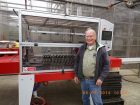
Features
Business
Grower Profiles
Celebrating 96 Years of Success
The business used to be 95 per cent wholesale and five per cent retail. However, that’s all changed as retail now accounts for 95 per cent of the business.
June 9, 2015 By Dr. Mohyuddin Mirza
 Among managers are, from left to right, front row: Sharon Wallish Murphy, Nellie Wallish and Charlie Wallish; at back, Glen Wallish, Louise Wallish and Dan Murphy.
Among managers are, from left to right, front row: Sharon Wallish Murphy, Nellie Wallish and Charlie Wallish; at back, Glen Wallish, Louise Wallish and Dan Murphy. I hadn’t talked with Charlie Wallish for some time, so when I saw an advertisement in the Edmonton Journal earlier this spring noting the company was celebrating 96 years in business, I jumped on the opportunity to meet again with him and his family.
Wallish Greenhouses began in 1913 when Charlie’s father, John Wallish, immigrated from Austria. In 1919, John started a market garden and laid the foundation starting point of the present 2.5-acre greenhouse close to Edmonton in Strathcona County.
THEIR FIRST GREENHOUSE WAS USED FOR VEGETABLE TRANSPLANTS
The first greenhouse was an eight-by-eight-foot structure used to grow vegetable transplants for the market garden.
John met his wife, Sally, in 1925 and started their family. Charlie was born in 1931 and recalls how his older brother Robert and sister Jean helped their dad in the market garden and greenhouse. I think that is when the foundation of the existing greenhouse was laid.
COLD FRAMES PUT TO GOOD USE FOR MARKET GARDEN
Charlie remembers their few cold frames in which all the cabbage transplants were grown for the market garden and likely for some extra sales as well. There was no heat! Specially woven straw mats were placed over these cold frames and covered with jute sacks. It was a ritual to remove the sacks and mats daily and then cover them at night!
Once in a while the cabbage transplants froze, but they recovered. Charlie also has a picture of the Edmonton Market where they used to market their produce.
The greenhouse business was started in 1963 when their parents “started” talking about retiring. That prompted Robert, Jean and Charlie to go into business together. Those were “lean” years, Charlie recalls, and every penny had to be spent carefully.
The first greenhouse was an 18-by-80-foot plastic structure. It was decided to save for it and pay with cash to avoid going into debt.
Cold frames were disposed of and three Quonsets and three greenhouses were built. Over time, more structures were added as the market for bedding plants and flowers expanded. More land was bought to grow field vegetables.
The original location is called “The Old Place,” and is situated on the east side of the North Saskatchewan River.
EARLY SOIL MIX INCLUDED PERLITE, VERMICULITE, PEAT MOSS AND LIME
During the early years, the growing medium included about 15 to 20 per cent good black dirt that was piled up when a road was built, along with perlite, vermiculite, peat moss and lime. The soil was then taken to the mushroom farm next door to be sterilized.
The business has long been widely known for its premium quality plants. I enjoyed my many meetings with Robert over the years when we talked about all aspects of greenhouse production.
Charlie took over the business after Robert passed away.
Years ago, and after the bedding plant season was completed, they grew cucumbers in Quonset houses with minimum heat. The timing was perfect, because they were able to supply customers before field cucumbers were harvested. Cucumbers are no longer grown, as the focus is on bedding and potted plants.
FAST-FORWARD TO 2015 AND A TOUR OF THE CURRENT OPERATIONS
Glen Wallish grew up in the business (or should I say with the business). He graduated from the University of Alberta and has a keen sense of business management and horticulture.
Once he decided on a new retail direction for the business, he started to steer it towards that goal.
The new Wallish Greenhouses operation opened in 1995 on Clover Bar Road in the County of Strathcona.
During my visit, I also spoke with Glen Wallish and co-worker Dan Murphy, and asked them for their ideas on why the business is so successful. I have summarized what I learned from them as follows.
The business used to be 95 per cent wholesale and five per cent retail. However, that’s all changed as retail now accounts for 95 per cent of the business.
The retail area is kept well stocked and absolutely clean. The floor is washed every morning.
The retail area has flood benches. It has made the watering job very easy and the crop is kept uniform.
The production area is also kept quite clean, helping ensure that disease and insect pressures are kept to a minimum.
LARGE DIVERSITY OF CROPS OFFERS SOMETHING FOR EVERYONE
Integrated pest management (IPM) practices are followed. They have to be especially diligent because over 1,000 types of products and plants are grown.
They have a very practical approach to labour management. They are flexible, but due to the seasonality of business, employees know that May is the busiest month and every effort is made to ensure adequate staffing levels are maintained.
Their seasonal employees are a mixture of semi-retired people along with young people looking for part-time work.
They are able to compete with big box stores based on their excellent quality and great customer service. Employees take the time to answer questions from customers and no one is rushed.
FLOOD BENCHES HAVE BEEN EFFECTIVE
They grow their own plugs. Flood benches were installed several years ago, and they have noticed very few algae issues.
They are constantly trying to create brand recognition. Their six-inch and four-inch pots have the Wallish Greenhouses logo, which includes the tagline – “A family tradition since 1919.”
They are quite happy with their sophisticated plug-transplanting machine. It has significantly cut down on labour costs.
They grow over 10,000, 12-inch baskets in fibre pots.
OZONATION USED TO TREAT THEIR RECYCLED WATER
They truck in water so they’re quite conscious of efficient water usage. Ozonation is used to treat their recycled water.
They used coal in the boilers years ago. However, natural gas is now the fuel of choice due to its stable supply.
They grow poinsettias for fundraisers and for retail sales. In this way, they are able to keep some of their staff employed for a longer period of time.
Do they have any expansion plans? Glen said that currently, they are enjoying the business with the size it is and there are no plans for growth. However, improvements, efficiencies and lean management principles have always been the focus of this business.
Dr. Mohyuddin Mirza is an industry consultant. Contact him at drmirzaconsultants@gmail.com.
Print this page




